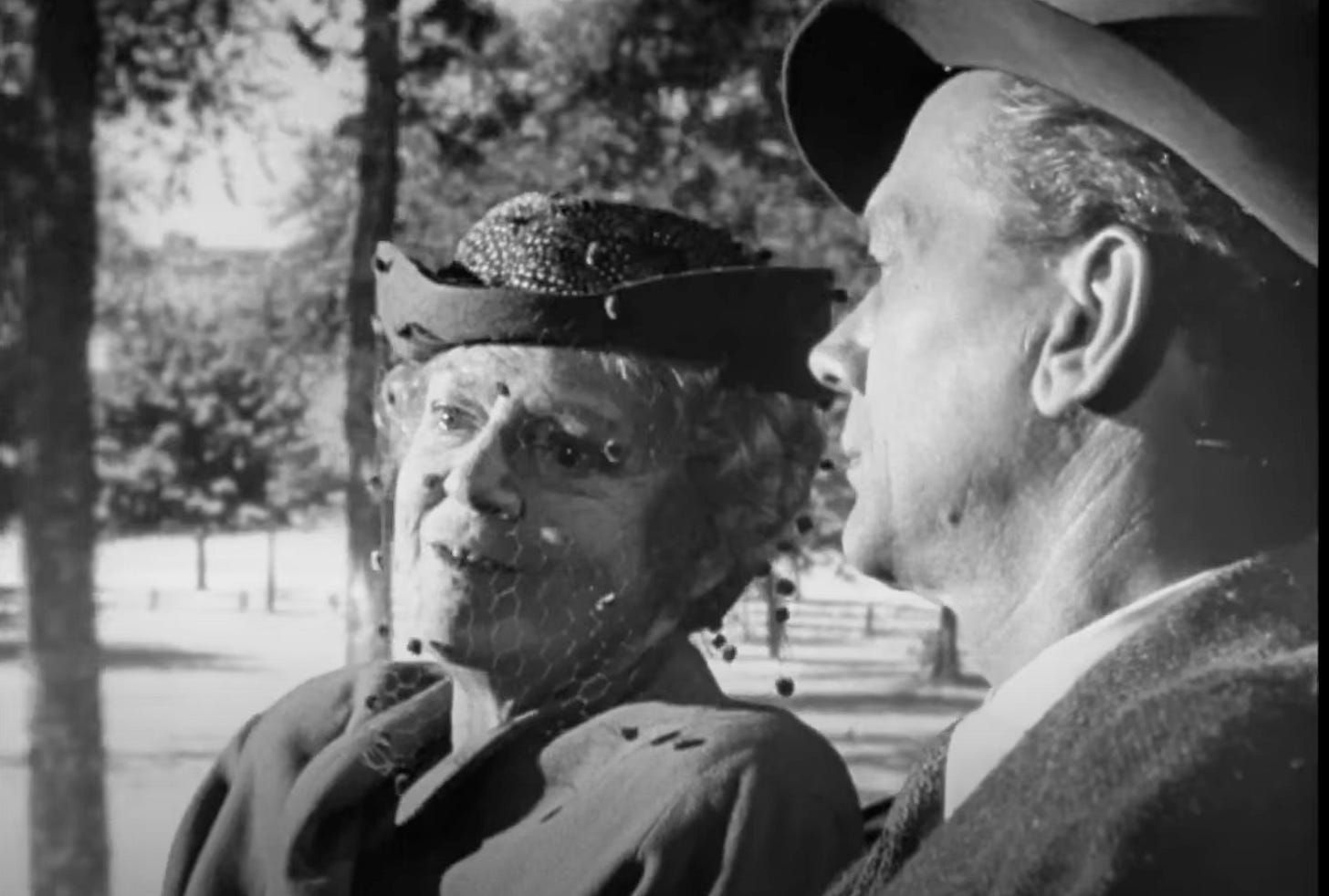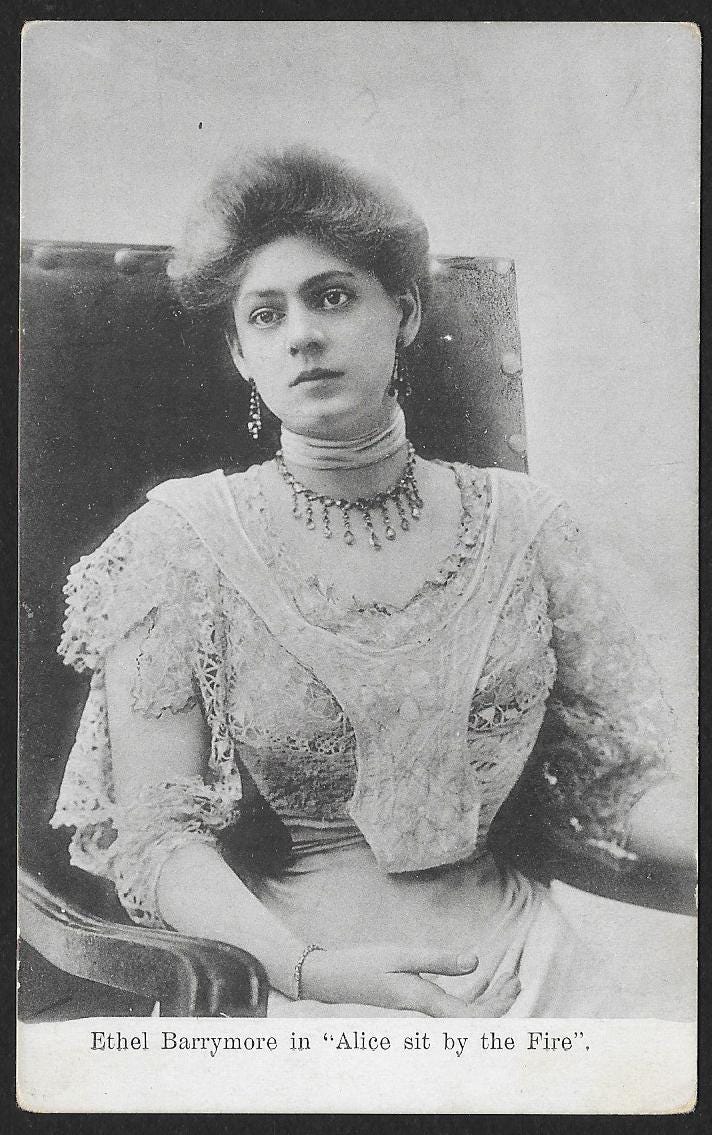My friend Bruce Benderson and I used to discuss Ethel Barrymore a lot, particularly one scene she did in Portrait of Jennie (1948) where her character is riding in a carriage and her face is wistful behind a veiled hat as she says, in her heart-catchingly lovely cello voice, “As you grow older…you begin to believe in lots of things you can’t see.”
What excited us was that Barrymore was so soulful at this moment, so moving, and yet there was a distant quality about her, too, that made us wonder if she was also thinking about getting laundry done or how many guests there would be for dinner as she acted, perfectly and beautifully. That’s what used to be called “technique,” and Barrymore, the first lady of the American stage all through the first half of the 20th century, was like a mountain of this kind of technique, or an eagle perched atop that mountain, wise, warm, ironic (as her brother John was), lyrical, yet not quite there.
The tone Barrymore strikes in her 1955 memoirs is one of both diffidence and conscientiousness. She had not wanted to go on the stage to earn her living; her dream had been to be a concert pianist. But her family were all actors, and once her mother died Barrymore went into acting in order to support herself as a teenager. It is difficult to imagine what she must have been like in her youth on the stage. We only have a handful of her movies from the 1910s as evidence of her work, and in those we are denied her most distinctive attribute, her speaking voice, but she brings a brooding intensity to The White Raven (1917), the only one of her five extant silent films that circulates (it can be seen below).
Barrymore made do, mainly, with rather light vehicles and played for a full three years in a Zoe Akins play called Déclassée, which the young Tallulah Bankhead saw 13 times. It was perhaps Bankhead’s imitations of Barrymore in Déclassée at the Algonquin Hotel that got it mocked by some of the Round Table wits, but Barrymore liked what she liked in the way of material and that was that. Or, as she famously said in a play called Sunday, “That’s all there is…there isn’t any more,” a line that became a kind of trademark for her.
It was only in 1932, when she was in her early fifties, that Barrymore appeared on the talking screen with her brothers John and Lionel for MGM in Rasputin and the Empress, a lavish prestige production in which Barrymore starts out well but soon begins widening her eyes and lingering over her vowels to excess; she doesn’t know yet the kind of acting that will be best for the camera.
There were lean years for her theatrically during the 1930s, but Barrymore had her biggest hit ever as the teacher Miss Moffat in Emlyn Williams’s autobiographical The Corn Is Green, which she also played for three years; this play was such a success for her that after a year of touring the company went right back out on tour for another year and played all the same cities again.
RKO wanted her so badly to play Cary Grant’s mother in None but the Lonely Heart (1944) that they paid the management of The Corn Is Green the full price of what they would have earned on the part of the tour that occurred during the filming in order to secure her. And that was a good idea, for Barrymore has understood here that for the camera, less is more. She is very touching as the mother to Grant’s Ernie Mott, tough, watchful, but tenderhearted underneath, and she roughens her grand voice in order to sound just working class enough for her role, a signal of her skill.
Barrymore won the Oscar for best supporting actress for None but the Lonely Heart, and she stayed on in Hollywood to do character roles, partly because her health could no longer stand the strain of travel and live performance after over half a century of devotion to the theater. She gave her most well-rounded screen performance in the very juicy role of the ultra-tough and managing invalid who watches over Dorothy McGuire in The Spiral Staircase (1946) and even played a villainous madwoman in Moss Rose (1947) with more than a tinge of that tasty Barrymore ham acting. Hitchcock made the most of her soulfulness in The Paradine Case (1947), though her best scene was cut and has not been recovered.
Barrymore took unworthy film roles by the 1950s, but she was a deservedly legendary figure at that point who had earned her rest and time in the California sun. In her last picture, Johnny Trouble (1957), she even recites a Shakespeare sonnet for us in the dulcet, ethereal tones that had warmed audiences for over 60 years. That’s all there is, there isn’t any more.







Splendid review of a great actresses remarkable career. She has never received enough detailed attention for her contribution to cinema. In general, I love the approach you are taking to film and culture. It complements what I'm trying to do on my own recently launched substack which I invite you to look at. Kind regards, Alan Zachary. zacharyonfilm.substack.com